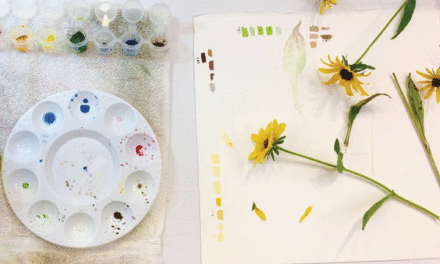One of the sweetest visual treats of spring is viewing those visiting bejeweled beauties, hummingbirds.
To keep the seasonal spectacle going, people often double down in their feeding efforts, dutifully purchasing or making syrup, filling, then rigorously cleaning hanging feeders.
But before enterprising individuals introduced the feeders’ flowing sugar water blend, hummingbirds managed to help themselves to natural nourishment, straight from flowers.
Cornell University’s Ornithology Lab’s free All About Birds blog recommends this “going natural” method. If you have room, Cornell suggests planting a native wildflower garden. But for those with less space, even a mini container garden can provide nutritional nectar and protein packed tiny bugs and spiders they require even more.
Kerry Wixted, Education and Outreach Specialist in Wildlife and Heritage at the Maryland Department of Natural Resources, is also a big fan of planting habitat to attract the ruby throated hummingbird, the only variety breeding here in Maryland.
In case you haven’t been counting, the tiny fliers are capable of flapping their wings over 50 times a second, Wixted advised in a DNR article last year (https://www.maryland.com/wild-maryland-return-of-the-ruby-throats/).
She also pointed out that “by planting native plants, you can provide both nectar and insects for hummingbirds to dine on,” notably “spiders, of particular importance as spider webbing is crucial for hummingbird nest construction.
“When we put out nectar and seed feeders to attract birds, we need to remember that we’re mainly doing this for our sake,” Wixted said.
And while the sugary nectar will help the adults stave off hunger, “those babies need more to really grow,” she added.
She urged people to differentiate between attracting birds and viably supporting their lifecycle.
Wixted said color, shape, and smell can all contribute in attracting hummingbirds to plants.
“Typically hummingbirds in our area are attracted to those plants that have those reddish and orange tubular shaped blooms, the design that allows them to get their tongues down in there to feed,” she noted.
But hummingbirds do see in color, as we do (unlike bees, who see in the UV spectrum so the world looks different to them than to us.), she added.
“A lot of these tubular flowers, the male parts, the stamens, are close to the tips, so when you see hummingbirds feeding on them, its actually depositing pollen on their foreheads, so when they go visit and visit another flower, a pollen exchange is actually happening also,” Wixted continued.
For handy reference, Wixted offered a list of 10 favorite floral delicacies to plant which will help the birds while providing scenic delight to observers.
While seven of the flowers are native varieties, Wixted also included three non-natives which are often more easily found at garden centers.
• Columbine (Aquilegia canadensis); native perennial;
• Bee balm (Monarda didyma); native perennial;
• Trumpet honeysuckle (Lonicera sempervirens); native vine;
• Trumpet creeper (Campsis radicans); native vine (caution can be aggressive);
• Spotted jewelweed (Impatiens capensis); native annual;
• Wild bergamot (Monarda fistulosa); native perennial;
• Cardinal flower (Lobelia canadensis); native perennial;
• Scarlet sage (Salvia coccinea); non-native annual;
• Pineapple sage (Salvia elegans); non-native annual; and
• Red buckeye (Aesculus pavia); non-native tree.
Members of the private Facebook group Hummingbird Lovers of DC, Virginia, and Maryland collectively compiled a more expansive list, featuring the following annuals: balsam, basil, 4 O’clocks, red hibiscus, hollyhock, Mexican sunflower, petunia, nasturtium, lantana, verbena, zinnia, and salvia varieties including ‘Black and Blue’ ‘Hot Lips’ ‘Summer Jewel Red’, ‘Love and Wishes’ and ‘Amistad’.
Perennial honorable mentions included cannas, cardinal flower, hosta, heliotrope, red hot poker, phlox, and ‘Wendy’s Wish’ salvia.
Hanging plants begonia ‘San Francisco’ and fuschia made the list, as did climbing annuals cardinal climber (mentioned as ‘a must’), morning glory, hyacinth and red pole bean, Spanish flag, and Cypress vine.
Perennial climbers were suggested with caveats, such as coral honeysuckle (red and orange cultivars only not yellow) and trumpet vine (invasive so plant in a container.)
Butterfly bush was also designated as invasive, while Rose of Sharon and abelia shrubs were safer non spreaders.
Help out those hummingbirds … naturally





